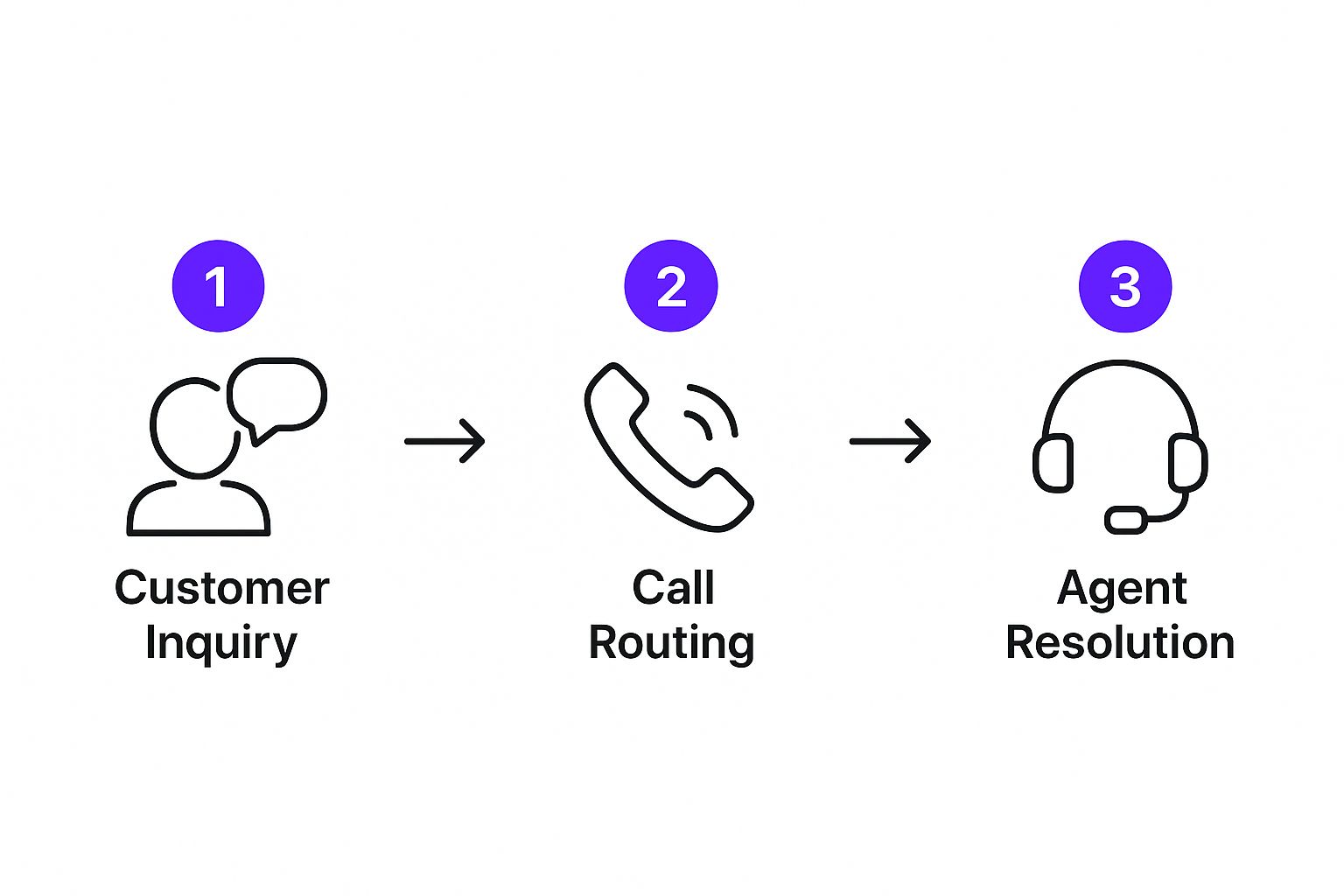Ever had a customer call your business, only to be met with a busy signal or voicemail? An inbound call center is the solution to that exact problem. It’s essentially a dedicated team—your business's central hub—for handling every single incoming phone call from customers.
Instead of your team juggling calls while trying to do their main jobs, this specialized group is laser-focused on responding to customer needs. Whether someone is calling for support, booking a service, or asking a question, a dedicated team is there to make sure no call goes unanswered. This simple change turns a ringing phone from a potential interruption into a genuine business opportunity.
Unpacking the Role of an Inbound Call Center

Think of an inbound call center as the professional front door to your business. It's not just a single receptionist trying to keep up; it’s a well-oiled system built to manage customer communications efficiently. The main goal is always the same: solve the caller's problem on that very first contact.
This is about so much more than just answering the phone. It's about creating a consistently positive experience that builds real trust and loyalty. For a home service company, that means every call about a burst pipe or a faulty furnace is met with a calm, professional voice ready to help, capturing business you might have otherwise lost to a competitor.
The Customer Expectation Factor
Let's be honest, today's customers expect immediate and reliable help, especially when they pick up the phone. In the United States, over 70% of consumers say excellent phone support is crucial, particularly for their most urgent problems. That high expectation sets a pretty clear standard for any business.
To keep customers happy, most call centers aim to answer 80% of calls within 20 seconds. The top performers in the industry push that even further, answering 90% of calls in just 15 seconds. If you're curious, you can explore more call center statistics to see just how much these numbers matter.
Ultimately, a great inbound operation ensures that when a customer needs you, they connect with a knowledgeable agent who can solve their problem right away. No long holds, no endless transfers—just solutions.
To put it simply, here’s a quick breakdown of what an inbound call center does day-to-day.
Inbound Call Center at a Glance
| Core Function | Primary Goal | Example Interaction |
|---|---|---|
| Customer Service & Support | Resolve issues and answer questions | A homeowner calls because their air conditioner isn't cooling, and the agent troubleshoots the problem or schedules a technician. |
| Appointment Scheduling | Fill the calendar with qualified leads | A potential customer calls for a quote on a new roof, and the agent books a time for an estimator to visit the property. |
| Order Processing & Sales | Handle incoming sales inquiries | A customer calls to renew their annual HVAC maintenance plan, and the agent processes the payment and confirms the service. |
As you can see, the focus is always on providing immediate value to the person on the other end of the line, which in turn drives business growth and customer satisfaction.
How an Inbound Call Center Works
Ever wonder what actually happens on the other end when a customer calls your business? It’s not just a phone ringing on a desk. The journey of an inbound call is a highly refined process, all designed to get the customer what they need as quickly and smoothly as possible.
Let’s stick with our example of a homeowner with a burst pipe. When they dial your plumbing company, they're probably stressed. The first thing they'll likely encounter is an Interactive Voice Response (IVR) system. This isn't just a robot voice; it's a smart initial filter. A simple menu—"Press 1 for emergency service, Press 2 for scheduling"—instantly sorts the call by urgency.
That first step is huge. It gets the customer on the right path from the very beginning.
Getting the Call to the Right Person
Once the IVR flags the call as an emergency, the Automatic Call Distribution (ACD) system kicks in. Think of the ACD as a savvy dispatcher for phone calls. It doesn't just send the call to the next free agent; it routes it to the best agent for the job.
For our frantic homeowner, the ACD will find an agent who is specifically trained to handle emergency plumbing calls. This person knows exactly what questions to ask and how to get a technician rolling, which cuts down resolution time dramatically. This simple, powerful workflow is the secret sauce.

This visual really captures that seamless handoff from the first "hello" to the final solution. That’s what an effective inbound system is all about.
Creating a Seamless Customer Experience
The moment the agent picks up the call, their screen lights up with the customer's entire history. This magic happens because the phone system is integrated with your Customer Relationship Management (CRM) software. The agent sees the homeowner's address, past service calls, and any important notes.
This instant access to context is what turns a potentially frustrating call into a fantastic one. The customer doesn't have to repeat their life story. The agent already has the background and can jump straight into solving the problem.
From there, the agent confirms the details, dispatches a plumber, and gives the homeowner an accurate ETA—all in one quick, professional interaction. To see just how much technology can help, it's worth learning how you can Automate Customer Support. By combining tools like IVR, ACD, and CRM, you turn a moment of panic for your customer into a moment of relief, building the kind of trust that keeps them coming back.
What an Inbound Call Center Actually Does for You

A good inbound call center is so much more than just a room full of people answering phones. Think of it as the central nervous system for your customer interactions—a dedicated hub that manages a whole range of communications to keep your business running smoothly and growing.
At its core, an inbound operation is built to handle any communication coming into your business. This isn't just about answering basic questions. It’s about turning every call, email, or chat into a productive step forward, whether that means solving a complex problem, making a sale, or scheduling a job.
Let's dive into the key services that make this happen.
Customer Support and Tech Help
One of the biggest jobs for an inbound team is providing top-notch technical support and customer service. For a home service company, this is your front line. It's where customers turn when they have a question about a recent installation or when something isn't working right.
Imagine a homeowner calls because their new water heater isn’t producing hot water. Instead of getting your voicemail, they reach a trained agent who can patiently guide them through a few troubleshooting steps. Often, this solves the problem on the spot. If not, the agent can instantly pull up warranty details and schedule a technician to come out.
That kind of immediate, helpful response doesn't just fix a problem—it shows the customer you’re reliable and builds real, lasting trust in your company.
This is absolutely critical for keeping customers happy after the sale. A single great support experience can easily turn someone who was frustrated into a loyal fan who recommends you to their neighbors.
Sales and Office Administration
Beyond just support, a sharp inbound team is a powerhouse for sales and admin tasks. They can handle everything from taking new orders to managing your schedule, making sure you never miss a lead or an opportunity.
Here’s a quick look at what this means in practice:
- Processing Orders and Payments: Agents can take a new service order right over the phone or process a payment for a recently completed job, giving your customers a secure and easy way to pay.
- Booking Appointments: When a new lead calls for an estimate, a call center agent can get them booked directly into your field team's calendar. This keeps your technicians busy and your revenue flowing.
- Handling Inquiries: Your team can answer all the common questions about your services, pricing, and availability. This frees up your in-house staff to focus on the hands-on work.
By taking on these essential jobs, an inbound call center acts like a seamless extension of your own office. It provides the backbone you need to handle more work and scale your business without getting bogged down.
The Benefits for Your Home Service Company

For any home service company, the advantages of a dedicated inbound call center aren't just theoretical—they're immediate and tangible. It’s not simply about having someone pick up the phone. It's about seizing every opportunity, especially when a customer's emergency happens long after you've clocked out for the day.
Think about it: a pipe bursts in a customer's basement at 2 AM. Without a 24/7 service, that frantic call goes to voicemail, and you can bet they’re calling your competitor next. An inbound center ensures a calm, professional agent answers that call, books the job, and turns a late-night crisis into a win for your business.
From Chaos to Control
Let's picture a local electrician—we'll call him Mike. He was drowning in missed calls while out on jobs. His voicemail was a jumbled mess of new leads, appointment changes, and questions from current clients. He was losing work and his reputation was taking a hit because he just couldn't be responsive enough.
Once he partnered with an inbound call center, everything changed. His schedule was suddenly optimized by pros who knew how to group appointments geographically. Every new lead was answered on the first ring, and customer inquiries were handled on the spot. This freed him up to actually focus on the electrical work he’s great at.
Mike didn't just get his sanity back; his revenue jumped by over 30% in the first six months. The call center did more than answer his phone—it brought order to his operations, elevated his customer service, and let him grow without the cost of a full-time office manager.
That kind of operational efficiency is a massive advantage. It means less time wasted driving across town and more time spent on profitable jobs.
Building Lasting Customer Relationships
Great service is the bedrock of any successful home service business. When customers feel heard and respected from the very first call, you start building real trust. A professional inbound call center makes sure every one of those interactions is handled perfectly.
This consistency delivers some powerful results:
- Never Miss a Lead: Every single call is a potential job. Having dedicated agents means you capture business that would have otherwise slipped through the cracks.
- Boost Professionalism: A well-trained agent represents your company exactly how you would, making you look more established and reliable than the competition.
- Earn Repeat Business: Happy customers come back. Great initial service turns a one-time repair into a lifelong relationship with a client who trusts you for everything.
Focusing on that customer journey is how you grow. It all begins with that first positive phone call. If you're looking for more ways to find new clients, take a look at our guide on contractor lead generation services.
The Technology Powering Modern Call Centers
When you picture a call center, you might imagine endless rows of cubicles with agents tethered to landline phones. That picture is decades out of date. Today’s inbound call centers are dynamic tech hubs, running on sophisticated software that makes every customer interaction smoother, smarter, and more efficient.
The single biggest leap forward has been the move from bulky, on-premise hardware to flexible, cloud-based systems. This isn't just a minor upgrade; it's a complete game-changer. It means a call center isn't tied to a physical building anymore. Agents can work from just about anywhere, whether it’s from home, another city, or even a different country.
This technology often goes beyond the desktop, offering powerful mobile access that lets managers and agents stay connected on the go. If you're curious about the full potential, you can unlock mobile access benefits for your team and see how it boosts operational freedom.
The Rise of AI in Customer Service
On top of the cloud revolution, Artificial Intelligence (AI) is completely reshaping how call centers function. AI isn't some far-off idea; it's a practical tool that's already handling routine tasks and helping human agents do their jobs better.
The proof is in the numbers. The global market for cloud-based contact centers was valued at USD 14.5 billion in 2021 and is expected to skyrocket to USD 82.43 billion by 2030. This incredible growth is almost entirely driven by businesses adopting AI and cloud platforms to get more efficient.
So, how does AI actually show up in a modern call center? Here are a couple of powerful examples:
- Intelligent Voice Bots: Think of these as your first line of defense. They can handle simple, common questions like "When is my appointment?" or "What are your business hours?" This frees up your human team to focus on the more complex customer problems that truly need their expertise.
- Agent-Assist Tools: This is where things get really smart. During a live call, AI can listen in and act as a real-time coach for your agent. It might pull up a customer's history, suggest the right answer to a tricky question, or provide a helpful script, all in a split second.
The bottom line is this: combining cloud flexibility with AI intelligence does a lot more than just save you money. It transforms your call center from a basic answering service into a powerful source of business intelligence, giving you a much deeper understanding of what your customers really want and need.
Finding the Right Partner for Your Calls
Knowing you need help answering the phone is one thing. Finding the right people to do it is a whole different ballgame. For any home service business, this isn't just about hiring a generic answering service; it’s about finding a team that gets the unique rhythm of your world—from the frantic "my basement is flooding" calls to the routine scheduling questions.
That’s why a specialized provider is so important. Think about it: you want someone who already knows the difference between a leaky faucet and a burst pipe. You need a team that can step in and represent your business with genuine know-how from the very first call.
A Solution Built for the Trades
This is exactly what we had in mind at Phone Staffer. We're not a jack-of-all-trades call center; we live and breathe home services. We don't just give you a number to forward calls to. We give you dedicated agents who are trained specifically for your industry, ensuring every customer feels heard and understood.
Our entire model is built on what businesses like yours actually need:
- Trade-Specific Training: Your agents come prepared to handle the real-world questions your customers ask every day.
- Always-On Availability: We’re here 24/7 because we know emergencies don't stick to a 9-to-5 schedule. You'll never miss another lead.
- Smart, Flexible Pricing: Our plans are designed to make professional call handling affordable, letting you scale up your support as your business takes off.
Choosing the right inbound call solution is about more than just outsourcing. It’s about finding a partner that feels like a true extension of your own crew—one that helps you book more jobs, keep customers happy, and free you up to do what you do best.
Have More Questions? Let's Get Them Answered
It's smart to have questions. Jumping into a partnership with an inbound call center is a big decision, so let's tackle a few of the practical things business owners always ask.
What’s the Real Difference Between an Inbound and an Outbound Call Center?
It all comes down to who’s making the call.
An inbound call center is all about receiving calls. When a customer has a leaky pipe, needs to book an HVAC tune-up, or wants a quote, they call you—and your inbound team answers. It's a customer-service-focused, reactive role that catches business as it comes in.
An outbound call center, on the other hand, is the one doing the dialing. Their agents are making outgoing calls for things like marketing promotions, following up on old leads, or conducting customer satisfaction surveys. Simply put, one is for catching, the other is for chasing.
What Should I Expect to Pay for an Inbound Call Center?
The cost really runs the gamut, and it depends entirely on what you need. There isn’t a one-size-fits-all price tag. Some providers offer a simple flat monthly rate, while others might charge by the minute or by the number of calls handled.
What you pay is usually shaped by a few key things:
- When you need coverage (just 9-to-5, or after-hours and weekends, too?)
- How many calls you typically get
- How much training the agents need to understand your specific services
The most important thing is finding a plan that fits your business like a glove. A solo electrician has very different needs—and a different budget—than a regional roofing company with five locations.
How Fast Can I Get This Up and Running?
You might be surprised. Getting set up is often much quicker than people think, sometimes in just a few days. A good provider has a smooth onboarding process that doesn’t waste your time. It usually just involves an initial chat to understand your goals, working together to nail down the call script, and giving the agents a quick rundown on your business.
Ready to see how a team of pros can help you stop missing calls, book more jobs, and give every customer a great experience? Phone Staffer provides agents who already know the home service industry and are ready to help you grow.

